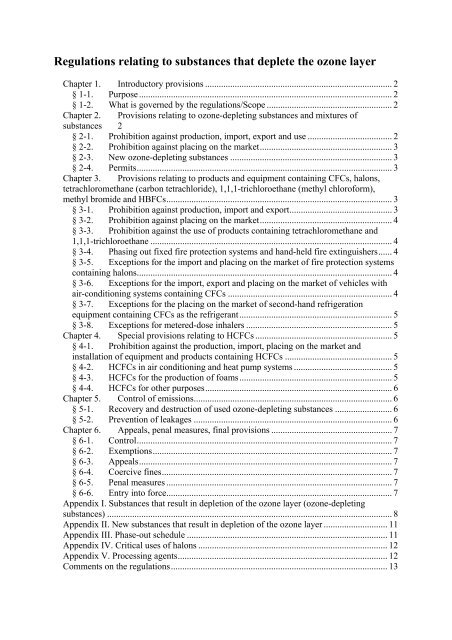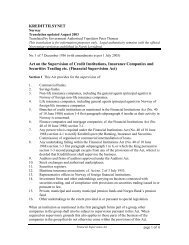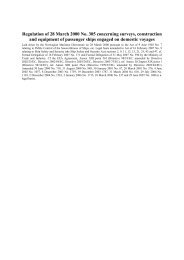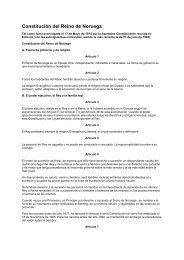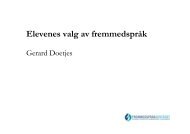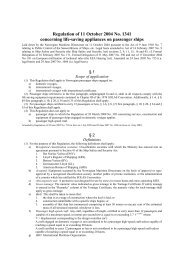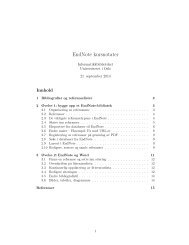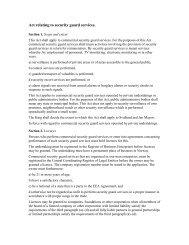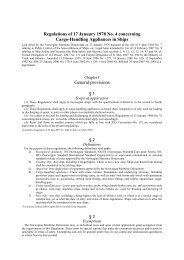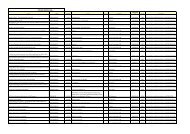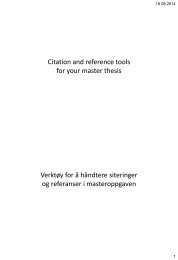Regulations relating to substances that deplete the ozone layer
Regulations relating to substances that deplete the ozone layer
Regulations relating to substances that deplete the ozone layer
You also want an ePaper? Increase the reach of your titles
YUMPU automatically turns print PDFs into web optimized ePapers that Google loves.
<strong>Regulations</strong> <strong>relating</strong> <strong>to</strong> <strong>substances</strong> <strong>that</strong> <strong>deplete</strong> <strong>the</strong> <strong>ozone</strong> <strong>layer</strong>Chapter 1. Introduc<strong>to</strong>ry provisions .................................................................................. 2§ 1-1. Purpose............................................................................................................... 2§ 1-2. What is governed by <strong>the</strong> regulations/Scope ....................................................... 2Chapter 2. Provisions <strong>relating</strong> <strong>to</strong> <strong>ozone</strong>-depleting <strong>substances</strong> and mixtures of<strong>substances</strong> 2§ 2-1. Prohibition against production, import, export and use ..................................... 2§ 2-2. Prohibition against placing on <strong>the</strong> market.......................................................... 3§ 2-3. New <strong>ozone</strong>-depleting <strong>substances</strong> ....................................................................... 3§ 2-4. Permits................................................................................................................ 3Chapter 3. Provisions <strong>relating</strong> <strong>to</strong> products and equipment containing CFCs, halons,tetrachloromethane (carbon tetrachloride), 1,1,1-trichloroethane (methyl chloroform),methyl bromide and HBFCs................................................................................................... 3§ 3-1. Prohibition against production, import and export............................................. 3§ 3-2. Prohibition against placing on <strong>the</strong> market.......................................................... 4§ 3-3. Prohibition against <strong>the</strong> use of products containing tetrachloromethane and1,1,1-trichloroethane .......................................................................................................... 4§ 3-4. Phasing out fixed fire protection systems and hand-held fire extinguishers...... 4§ 3-5. Exceptions for <strong>the</strong> import and placing on <strong>the</strong> market of fire protection systemscontaining halons................................................................................................................ 4§ 3-6. Exceptions for <strong>the</strong> import, export and placing on <strong>the</strong> market of vehicles withair-conditioning systems containing CFCs ........................................................................ 4§ 3-7. Exceptions for <strong>the</strong> placing on <strong>the</strong> market of second-hand refrigerationequipment containing CFCs as <strong>the</strong> refrigerant................................................................... 5§ 3-8. Exceptions for metered-dose inhalers ................................................................ 5Chapter 4. Special provisions <strong>relating</strong> <strong>to</strong> HCFCs ............................................................ 5§ 4-1. Prohibition against <strong>the</strong> production, import, placing on <strong>the</strong> market andinstallation of equipment and products containing HCFCs ............................................... 5§ 4-2. HCFCs in air conditioning and heat pump systems ........................................... 5§ 4-3. HCFCs for <strong>the</strong> production of foams................................................................... 5§ 4-4. HCFCs for o<strong>the</strong>r purposes.................................................................................. 6Chapter 5. Control of emissions....................................................................................... 6§ 5-1. Recovery and destruction of used <strong>ozone</strong>-depleting <strong>substances</strong> ......................... 6§ 5-2. Prevention of leakages ....................................................................................... 6Chapter 6. Appeals, penal measures, final provisions ..................................................... 7§ 6-1. Control................................................................................................................ 7§ 6-2. Exemptions......................................................................................................... 7§ 6-3. Appeals............................................................................................................... 7§ 6-4. Coercive fines..................................................................................................... 7§ 6-5. Penal measures ................................................................................................... 7§ 6-6. Entry in<strong>to</strong> force................................................................................................... 7Appendix I. Substances <strong>that</strong> result in depletion of <strong>the</strong> <strong>ozone</strong> <strong>layer</strong> (<strong>ozone</strong>-depleting<strong>substances</strong>) ............................................................................................................................. 8Appendix II. New <strong>substances</strong> <strong>that</strong> result in depletion of <strong>the</strong> <strong>ozone</strong> <strong>layer</strong> ............................ 11Appendix III. Phase-out schedule ........................................................................................ 11Appendix IV. Critical uses of halons ................................................................................... 12Appendix V. Processing agents............................................................................................ 12Comments on <strong>the</strong> regulations............................................................................................... 13
2<strong>Regulations</strong> <strong>relating</strong> <strong>to</strong> <strong>substances</strong> <strong>that</strong> <strong>deplete</strong> <strong>the</strong> <strong>ozone</strong> <strong>layer</strong>Laid down by <strong>the</strong> Ministry of <strong>the</strong> Environment on 20 December 2002 pursuant <strong>to</strong> sections114, 117 and 124 of <strong>the</strong> Act of 9 June 1903 No. 7 <strong>relating</strong> <strong>to</strong> State Control of <strong>the</strong>Seaworthiness of Ships etc., cf Royal Decree of 12 Oc<strong>to</strong>ber 1979 No. 1, and <strong>to</strong> sections 3, 4,8, 12 and 13 of <strong>the</strong> Act of 11 June 1976 No. 79 <strong>relating</strong> <strong>to</strong> <strong>the</strong> Control of Products andConsumer Services (<strong>the</strong> Product Control Act), cf. Crown Prince Regent’s Decree of 7September 1990 No. 730. Cf. <strong>the</strong> EEA Agreement, Annex XX, paragraph 21 aa (Regulation(EC) No. 2037/2000).Chapter 1. Introduc<strong>to</strong>ry provisions§ 1-1. PurposeThe purpose of <strong>the</strong>se regulations is <strong>to</strong> prevent emissions of <strong>substances</strong> <strong>that</strong> result in depletionof <strong>the</strong> stra<strong>to</strong>spheric <strong>ozone</strong> <strong>layer</strong>.§ 1-2. What is governed by <strong>the</strong> regulations/ScopeThese regulations lay down provisions governing <strong>the</strong> production, import, export, placing on<strong>the</strong> market, use, recovery, recycling, reclamation and destruction of <strong>ozone</strong>-depleting<strong>substances</strong>, and on <strong>the</strong> production, import, export, placing on <strong>the</strong> market and use of productsand equipment containing subtances <strong>that</strong> may result in depletion of <strong>the</strong> stra<strong>to</strong>spheric <strong>ozone</strong><strong>layer</strong>.For <strong>the</strong> purpose of <strong>the</strong>se regulations, <strong>the</strong> term <strong>ozone</strong>-depleting <strong>substances</strong> means those<strong>substances</strong> <strong>that</strong> are listed in Appendix I <strong>to</strong> <strong>the</strong> regulations. The term new <strong>ozone</strong>-depleting<strong>substances</strong> means those <strong>substances</strong> <strong>that</strong> are listed in Appendix II.These regulations apply within <strong>the</strong> realm, including Svalbard and Jan Mayen, on boardNorwegian ships, on board Norwegian aircraft in areas <strong>that</strong> are not under <strong>the</strong> sovereignty ofany state and on installations and facilities on <strong>the</strong> Norwegian continental shelf.Chapter 2. Provisions <strong>relating</strong> <strong>to</strong> <strong>ozone</strong>-depleting <strong>substances</strong> and mixturesof <strong>substances</strong>§ 2-1. Prohibition against production, import, export and useIt is prohibited <strong>to</strong> produce, import, export or use <strong>ozone</strong>-depleting <strong>substances</strong>, whe<strong>the</strong>r alone orin a mixture, unless this is permitted pursuant <strong>to</strong> this section, chapter 3 or 4, or in accordancewith a special permit issued pursuant <strong>to</strong> section 2-4.The prohibition against <strong>the</strong> use of CFCs, tetrachloromethane and 1,1,1-trichloroethane aloneor in a mixture does not apply <strong>to</strong> <strong>the</strong>ir use for labora<strong>to</strong>ry purposes up <strong>to</strong> 31 December 2005. Itis never<strong>the</strong>less prohibited <strong>to</strong> use <strong>ozone</strong>-depleting <strong>substances</strong> for oil-in-water analyses.The prohibition against <strong>the</strong> use of <strong>ozone</strong>-depleting <strong>substances</strong> does not apply <strong>to</strong> <strong>the</strong>ir use asfeeds<strong>to</strong>ck in <strong>the</strong> production of o<strong>the</strong>r chemicals, provided <strong>that</strong> such <strong>substances</strong> are completelyconverted during <strong>the</strong> process and <strong>the</strong>ir emissions are insignificant.
3The prohibition against <strong>the</strong> production of <strong>ozone</strong>-depleting <strong>substances</strong> does not apply <strong>to</strong> <strong>ozone</strong>depleting<strong>substances</strong> <strong>that</strong> are formed in insignificant quantities during <strong>the</strong> manufacture ofo<strong>the</strong>r <strong>substances</strong>.§ 2-2. Prohibition against placing on <strong>the</strong> marketIt is prohibited <strong>to</strong> place <strong>the</strong> following <strong>ozone</strong>-depleting <strong>substances</strong> on <strong>the</strong> market whe<strong>the</strong>r aloneor in a mixture without a special permit pursuant <strong>to</strong> section 2-4:CFCs, halons, tetrachloromethane (carbon tetrachloride), 1,1,1- trichloroethane (methylchloroform) and HBFCs.The prohibition against placing of halons on <strong>the</strong> market does not apply <strong>to</strong> placing on <strong>the</strong>market for purposes <strong>that</strong> are permitted pursuant <strong>to</strong> Chapter 3.§ 2-3. New <strong>ozone</strong>-depleting <strong>substances</strong>It is prohibited <strong>to</strong> produce, import, export, place on <strong>the</strong> market or use <strong>the</strong> new <strong>ozone</strong>-depleting<strong>substances</strong> listed in Appendix II.The Norwegian Pollution Control Authority or <strong>the</strong> instance prescribed by <strong>the</strong> Ministry of <strong>the</strong>Environment may by regulations add new <strong>substances</strong> <strong>to</strong> Appendix II if <strong>the</strong>y are found by <strong>the</strong>Scientific Assessment Panel under <strong>the</strong> Montreal Pro<strong>to</strong>col <strong>to</strong> have a significant <strong>ozone</strong>depletingeffect.§ 2-4. PermitsThe Norwegian Pollution Control Authority or <strong>the</strong> instance prescribed by <strong>the</strong> Ministry of <strong>the</strong>Environment may issue permits for <strong>the</strong> production, import, export, placing on <strong>the</strong> market anduse of <strong>ozone</strong>-depleting <strong>substances</strong> and mixtures of <strong>substances</strong>.Permits for <strong>the</strong> production and import of HCFCs and methyl bromide may only be issued inaccordance with <strong>the</strong> phase-out schedule in Appendix III or with Norway’s obligations underinternational law.Ozone-depleting <strong>substances</strong> and mixtures of <strong>substances</strong> shall in any case not be produced,imported or placed on <strong>the</strong> market in disposable containers, except for essential uses.Chapter 3. Provisions <strong>relating</strong> <strong>to</strong> products and equipment containingCFCs, halons, tetrachloromethane (carbon tetrachloride), 1,1,1-trichloroethane (methyl chloroform), methyl bromide andHBFCs§ 3-1. Prohibition against production, import and exportIt is prohibited <strong>to</strong> produce, import or export products and equipment containing <strong>the</strong> following<strong>ozone</strong>-depleting <strong>substances</strong>:CFCs, halons, tetrachloromethane (carbon tetrachloride), 1,1,1-trichloroethane (methylchloroform), methyl bromide and HBFCs.It is also prohibited <strong>to</strong> export products whose continuing function relies on supply of <strong>the</strong><strong>substances</strong> listed in <strong>the</strong> first paragraph.
4§ 3-2. Prohibition against placing on <strong>the</strong> marketIt is prohibited <strong>to</strong> place on <strong>the</strong> market products and equipment containing <strong>the</strong> following<strong>ozone</strong>-depleting <strong>substances</strong>:CFCs, halons, tetrachloromethane (carbon tetrachloride), 1,1,1-trichloroethane (methylchloroform) and HBFCs.§ 3-3. Prohibition against <strong>the</strong> use of products containing tetrachloromethane and 1,1,1-trichloroethaneIt is prohibited <strong>to</strong> use products containing tetrachloromethane (carbon tetrachloride) or 1,1,1-trichloroethane (methyl chloroform).§ 3-4. Phasing out fixed fire protection systems and hand-held fire extinguishersHand-held fire extinguishers containing halons shall be decommissioned by 31 December2003.It is prohibited <strong>to</strong> install or possess fixed fire protection systems containing halons.Never<strong>the</strong>less, it is permitted <strong>to</strong> possess fixed fire protection systems containing halons onships and mobile installations until 31 December 2003.The prohibitions against fixed fire protection systems and hand-held fire extinguisherscontaining halons set out in <strong>the</strong> first and second paragraphs do not apply <strong>to</strong> critical uses asdefined in Appendix IV.The prohibition against <strong>the</strong> use of halons in section 2-1 does not apply <strong>to</strong> recharging withhalons for critical uses as defined in Appendix IV.§ 3-5. Exceptions for <strong>the</strong> import and placing on <strong>the</strong> market of fire protection systemscontaining halonsThe prohibitions of sections 3-1 and 3-2 against <strong>the</strong> import and placing on <strong>the</strong> market ofproducts and equipment do not apply <strong>to</strong> fire protection systems containing halons for criticaluses as defined in Appendix IV.§ 3-6. Exceptions for <strong>the</strong> import, export and placing on <strong>the</strong> market of vehicles with airconditioningsystems containing CFCsThe prohibition of section 3-2 against placing on <strong>the</strong> market does not apply <strong>to</strong> vehicles withair-conditioning systems containing CFCs if <strong>the</strong> vehicle was imported before 31 December1993 or if <strong>the</strong> air-conditioning system was installed in <strong>the</strong> vehicle before 1 July 1991, or ifimport or installation <strong>to</strong>ok place at a later date in accordance with an exemption granted by<strong>the</strong> Norwegian Pollution Control Authority pursuant <strong>to</strong> <strong>the</strong> <strong>Regulations</strong> of 21 January 1991No. 55 <strong>relating</strong> <strong>to</strong> <strong>the</strong> manufacture, import, export and use of chlorofluorocarbons (CFCs) andhalons.The prohibition of section 3-1 against import and export and <strong>the</strong> prohibition of 3-2 againstplacing on <strong>the</strong> market do not apply <strong>to</strong> vehicles manufactured before 1 Oc<strong>to</strong>ber 2000 if <strong>the</strong>vehicle is imported or exported as household goods when <strong>the</strong> owner moves <strong>to</strong> or fromNorway, or if <strong>the</strong> vehicle is of his<strong>to</strong>rical interest, see sections 1-8 and 1-9 of <strong>the</strong> <strong>Regulations</strong>of 4 Oc<strong>to</strong>ber 1994 No. 918 <strong>relating</strong> <strong>to</strong> mo<strong>to</strong>r vehicles.
5§ 3-7. Exceptions for <strong>the</strong> placing on <strong>the</strong> market of second-hand refrigeration equipmentcontaining CFCs as <strong>the</strong> refrigerantThe prohibition of section 3-2 against placing on <strong>the</strong> market does not apply <strong>to</strong> second-handrefrigeration equipment containing CFCs as <strong>the</strong> refrigerant if <strong>the</strong> refrigerant charge is lessthan 1 kg per unit and if <strong>the</strong> equipment was manufactured before 1 July 1991 or at a later datein accordance with an exemption granted by <strong>the</strong> Norwegian Pollution Control Authoritypursuant <strong>to</strong> <strong>the</strong> <strong>Regulations</strong> of 21 January 1991 No. 55 <strong>relating</strong> <strong>to</strong> <strong>the</strong> manufacture, import,export and use of chlorofluorocarbons (CFCs) and halons.§ 3-8. Exceptions for metered-dose inhalersThese regulations do not preclude <strong>the</strong> import and placing on <strong>the</strong> market of medicinal productsof <strong>the</strong> types known as metered-dose inhalers (MDI) <strong>that</strong> contain CFCs.Chapter 4. Special provisions <strong>relating</strong> <strong>to</strong> HCFCs§ 4-1. Prohibition against <strong>the</strong> production, import, placing on <strong>the</strong> market andinstallation of equipment and products containing HCFCsIt is prohibited <strong>to</strong> produce, import, place on <strong>the</strong> market or install equipment and productscontaining HCFCs. However, for equipment and products regulated by this chapter, <strong>the</strong>prohibition against production, import, placing on <strong>the</strong> market and installation does not applyuntil <strong>the</strong> date on which <strong>the</strong> restriction enters in<strong>to</strong> force. Products and equipment <strong>that</strong> areproduced before <strong>the</strong> restrictions on use enter in<strong>to</strong> force may never<strong>the</strong>less be imported, placedon <strong>the</strong> market and installed.§ 4-2. HCFCs in air conditioning and heat pump systemsThe prohibition of section 2-1 against <strong>the</strong> use of HCFCs does not apply until:- 1 January 2004 for equipment for reversible air-conditioning/heat pump systemsproduced after 31 December 2003.- 31 December 2008 for military uses of mo<strong>to</strong>r vehicles, trac<strong>to</strong>rs, off-road vehicles andtrailers.The prohibition of section 2-1 against <strong>the</strong> use of HCFCs does not apply <strong>to</strong> <strong>the</strong> recharging ormaintenance of refrigeration and air-conditioning equipment <strong>that</strong> was lawfully produced,imported, placed on <strong>the</strong> market or installed pursuant <strong>to</strong> earlier legislation. From 1 January2010 it is never<strong>the</strong>less prohibited <strong>to</strong> use virgin HCFCs in <strong>the</strong> recharging and maintenance ofsuch refrigeration and air-conditioning equipment. From 1 January 2015, recharging andmaintenance with used or recovered HCFCs is also prohibited.§ 4-3. HCFCs for <strong>the</strong> production of foamsThe prohibition of section 2-1 against <strong>the</strong> use of HCFCs does not apply <strong>to</strong> <strong>the</strong> production ofrigid insulating foams until 1 January 2004.It is never<strong>the</strong>less prohibited <strong>to</strong> use HCFCs in <strong>the</strong> production of :- polyethylene insulating foams,- polyurethane foams for appliances and machines,- polyurethane flexible-faced laminate foams,- polyurethane sandwich panel and- extruded polystyrene foams.
7Chapter 6. Appeals, penal measures, final provisions§ 6-1. ControlThe Norwegian Pollution Control Authority or <strong>the</strong> instance prescribed by <strong>the</strong> Ministry of <strong>the</strong>Environment will be responsible for ensuring compliance with <strong>the</strong>se regulations. TheNorwegian Maritime Direc<strong>to</strong>rate will be responsible for ensuring compliance with <strong>the</strong>seregulations on board civilian Norwegian vessels.§ 6-2. ExemptionsThe Norwegian Pollution Control Authority or <strong>the</strong> instance prescribed by <strong>the</strong> Ministry of <strong>the</strong>Environment may in special cases grant exemptions from <strong>the</strong>se regulations. Exemptions mayonly be granted provided <strong>that</strong> <strong>the</strong>y are in accordance with Norway’s obligations underinternational law.§ 6-3. AppealsIndividual decisions made by <strong>the</strong> Norwegian Pollution Control Authority or <strong>the</strong> NorwegianMaritime Direc<strong>to</strong>rate pursuant <strong>to</strong> <strong>the</strong>se regulations may be appealed <strong>to</strong> <strong>the</strong> Ministry of <strong>the</strong>Environment.§ 6-4. Coercive finesIn order <strong>to</strong> ensure compliance with <strong>the</strong>se regulations or decisions made pursuant <strong>the</strong>re<strong>to</strong>, <strong>the</strong>instance responsible for control may impose coercive fines in accordance with <strong>the</strong> provisionsof section 13 of <strong>the</strong> Product Control Act or section 124 of <strong>the</strong> Act <strong>relating</strong> <strong>to</strong> State Control of<strong>the</strong> Seaworthiness of Ships.§ 6-5. Penal measuresAny contravention of <strong>the</strong>se regulations or of decisions made pursuant <strong>the</strong>re<strong>to</strong> is liable <strong>to</strong> apenalty in accordance with section 12 of <strong>the</strong> Product Control Act or section 427 of <strong>the</strong> PenalCode.§ 6-6. Entry in<strong>to</strong> forceThese regulations enter in<strong>to</strong> force on 1 January 2003. From <strong>the</strong> same date, <strong>the</strong> followingregulations are repealed:- <strong>Regulations</strong> of 21 January 1991 No. 55 <strong>relating</strong> <strong>to</strong> <strong>the</strong> manufacture, import, export and useof chlorofluorocarbons (CFCs) and halons- Temporary regulations of 26 August 1994 No. 857 <strong>relating</strong> <strong>to</strong> exemptions from <strong>the</strong>regulations <strong>relating</strong> <strong>to</strong> <strong>the</strong> manufacture, import, export and use of chlorofluorocarbons (CFCs)and halons from refrigerating and freezing equipment, air-conditioning equipment in vehicles,duty <strong>to</strong> deliver CFCs removed from such equipment, and halons for fire-extinguishing- <strong>Regulations</strong> of 28 March 1995 No. 277 <strong>relating</strong> <strong>to</strong> prohibition of <strong>the</strong> manufacture, import,export and use of 1,1,1-trichloroethane (methyl chloroform)- <strong>Regulations</strong> of 28 March 1995 No. 278 <strong>relating</strong> <strong>to</strong> <strong>the</strong> manufacture, import, export and useof tetrachloromethane (carbon tetrachloride)- <strong>Regulations</strong> of 25 September 1996 No. 996 <strong>relating</strong> <strong>to</strong> <strong>the</strong> manufacture, import, export anduse of hydrobromofluorocarbons (HBFCs)- <strong>Regulations</strong> of 14 July 1997 No. 789 <strong>relating</strong> <strong>to</strong> <strong>the</strong> manufacture, import, export and use ofmethyl bromide- <strong>Regulations</strong> of 14 July 1997 No. 790 <strong>relating</strong> <strong>to</strong> <strong>the</strong> manufacture, import, export and use ofhydrochlorofluorocarbons (HCFCs), etc.
8Appendix I. Substances <strong>that</strong> result in depletion of <strong>the</strong> <strong>ozone</strong> <strong>layer</strong> (<strong>ozone</strong>depleting<strong>substances</strong>)Chlorofluorocarbons (CFCs)Chemical formula Trade name ODP fac<strong>to</strong>r *CFCl 3 (CFC 11) 1.0CF 2 Cl 2 (CFC 12) 1.0C 2 F 3 Cl 2 (CFC 113) 0.8C 2 F 4 Cl 2 (CFC 114) 1.0C 2 F 5 Cl (CFC 115) 0.6CF 3 Cl (CFC 13) 1.0C 2 FCl 5 (CFC 111) 1.0C 2 F 2 Cl 4 (CFC 112) 1.0C 3 FCl 7 (CFC 211) 1.0C 3 F 2 Cl 6 (CFC 212) 1.0C 3 F 3 Cl 5 (CFC 213) 1.0C 3 F 4 Cl 4 (CFC 214) 1.0C 3 F 4 Cl 3 (CFC 215) 1.0C 3 F 6 Cl 2 (CFC 216) 1.0C 3 F 7 Cl (CFC 217) 1.0* ODP (<strong>ozone</strong>-depleting potential) indicates <strong>the</strong> relative capacity of each substance fordepleting <strong>the</strong> <strong>ozone</strong> <strong>layer</strong>.HalonsChemical formula Trade name ODP fac<strong>to</strong>r *CF 2 BrCl (halon 1211) 3.0CF 3 Br (halon 1301) 10.0C 2 F 4 Br 2 (halon 2402) 6.0* ODP (<strong>ozone</strong>-depleting potential) indicates <strong>the</strong> relative capacity of each substance fordepleting <strong>the</strong> <strong>ozone</strong> <strong>layer</strong>.Tetrachloromethane (carbon tetrachloride)Chemical formula Trade name ODP fac<strong>to</strong>r *CCl 4 1.1* ODP (<strong>ozone</strong>-depleting potential) indicates <strong>the</strong> relative capacity of each substance fordepleting <strong>the</strong> <strong>ozone</strong> <strong>layer</strong>.1,1,1-trichloroethane (methyl chloroform)
9Chemical formula Trade name ODP fac<strong>to</strong>r *C 2 H 3 Cl 3 0.1* ODP (<strong>ozone</strong>-depleting potential) indicates <strong>the</strong> relative capacity of each substance fordepleting <strong>the</strong> <strong>ozone</strong> <strong>layer</strong>.Methyl bromideChemical formula Trade name ODP fac<strong>to</strong>r *CH 3 Br 0.6* ODP (<strong>ozone</strong>-depleting potential) indicates <strong>the</strong> relative capacity of each substance fordepleting <strong>the</strong> <strong>ozone</strong> <strong>layer</strong>.Hydrobromofluorocarbons (HBFCs)Chemical formula Trade name ODP fac<strong>to</strong>r *CHFBr 2 1.00CHF 2 Br (HBFC-22B1) 0.74CH 2 FBr 0.73C 2 HFBr 4 0.8C 2 HF 2 Br 3 1.8C 2 HF 3 Br 2 1.6C 2 HF 4 Br 1.2C 2 H 2 FBr 3 1.1C 2 H 2 F 2 Br 2 1.5C 2 H 2 F 3 Br 1.6C 2 H 3 FBr 2 1.7C 2 H 3 F 2 Br 1.1C 2 H 4 FBr 0.1C 3 HFBr 6 1.5C 3 HF 2 Br 5 1.9C 3 HF 3 Br 4 1.8C 3 HF 4 Br 3 2.2C 3 HF 5 Br 2 2.0C 3 HF 6 Br 3.3C 3 H 2 FBr 5 1.9C 3 H 2 F 2 Br 4 2.1
10C 3 H 2 F 3 Br 3 5.6C 3 H 2 F 4 Br 2 7.5C 3 H 2 F 5 Br 1.4C 3 H 3 FBr 4 1.9C 3 H 3 F 2 Br 3 3.1C 3 H 3 F 3 Br 2 2.5C 3 H 3 F 4 Br 4.4C 3 H 4 FBr 3 0.3C 3 H 4 F 2 Br 2 1.0C 3 H 4 F 3 Br 0.8C 3 H 5 FBr 2 0.4C 3 H 5 F 2 Br 0.8C 3 H 6 FBr 0.7* ODP (<strong>ozone</strong>-depleting potential) indicates <strong>the</strong> relative capacity of each substance fordepleting <strong>the</strong> <strong>ozone</strong> <strong>layer</strong>.Hydrochlorofluorocarbons (HCFCs)Chemical formula Trade name ODP fac<strong>to</strong>r *CHFCl 2 (HCFC-21) 0.040CHF 2 Cl (HCFC-22) 0.055CH 2 FCl (HCFC-31) 0.020C 2 HFCl 4 (HCFC-121) 0.040C 2 HF 2 Cl 3 (HCFC-122) 0.080C 2 HF 3 Cl 2 (HCFC-123) 0.020C 2 HF 4 Cl (HCFC-124) 0.022C 2 H 2 FCl 3 (HCFC-131) 0.050C 2 H 2 F 2 Cl 2 (HCFC-132) 0.050C 2 H 2 F 3 Cl (HCFC-133) 0.060C 2 H 3 FCl 2 (HCFC-141) 0.070CH 3 CFCl 2 (HCFC-141b) 0.110C 2 H 3 F 2 Cl (HCFC-142) 0.070CH 3 CF 2 Cl (HCFC-142b) 0.065C 2 H 4 FCl (HCFC-151) 0.005C 3 HFCl 6 (HCFC-221) 0.070C 3 HF 2 Cl 5 (HCFC-222) 0.090C 3 HF 3 Cl 4 (HCFC-223) 0.080C 3 HF 4 Cl 3 (HCFC-224) 0.090
11C 3 HF 5 Cl 2 (HCFC-225) 0.070CF 3 CF 2 CHCl 2 (HCFC-225ca) 0.025CF 2 ClCF 2 CHClF (HCFC-225cb) 0.033C 3 HF 6 Cl (HCFC-226) 0.100C 3 H 2 FCl 5 (HCFC-231) 0.090C 3 H 2 F 2 Cl 4 (HCFC-232) 0.100C 3 H 2 F 3 Cl 3 (HCFC-233) 0.230C 3 H 2 F 4 Cl 2 (HCFC-234) 0.280C 3 H 2 F 5 Cl (HCFC-235) 0.520C 3 H 3 FCl 4 (HCFC-241) 0.090C 3 H 3 F 2 Cl 3 (HCFC-242) 0.130C 3 H 3 F 3 Cl 2 (HCFC-243) 0.120C 3 H 3 F 4 Cl (HCFC-244) 0.140C 3 H 4 FCl 3 (HCFC-251) 0.010C 3 H 4 F 2 Cl 2 (HCFC-252) 0.040C 3 H 4 F 3 Cl (HCFC-253) 0.030C 3 H 5 FCl 2 (HCFC-261) 0.020C 3 H 5 F 2 Cl (HCFC-262) 0.020C 3 H 6 FCl (HCFC-271) 0.030* ODP (<strong>ozone</strong>-depleting potential) indicates <strong>the</strong> relative capacity of each substance fordepleting <strong>the</strong> <strong>ozone</strong> <strong>layer</strong>.Appendix II. New <strong>substances</strong> <strong>that</strong> result in depletion of <strong>the</strong> <strong>ozone</strong> <strong>layer</strong>BromochloromethaneN-propyl bromideAppendix III. Phase-out scheduleHydrochlorofluorocarbons (HCFCs)15 per cent reduction from 1 January 200255 per cent reduction from 1 January 200370 per cent reduction from 1 January 200475 per cent reduction from 1 January 2008100 per cent reduction from 1 January 2010The reductions are <strong>to</strong> be calculated in relation <strong>to</strong> a base level corresponding <strong>to</strong> <strong>the</strong>consumption of HCFCs in 1989 plus 2.0 per cent of <strong>the</strong> consumption of CFCs in 1989,weighted by ODP fac<strong>to</strong>rs (ODP <strong>to</strong>nnes).Methyl bromide
1260 per cent reduction from 1 January 200175 per cent reduction from 1 January 2003100 per cent reduction from 1 January 2005The reductions are <strong>to</strong> be calculated on <strong>the</strong> basis of methyl bromide consumption in 1991.Appendix IV. Critical uses of halonsUse of halon 1301:- in aircraft for <strong>the</strong> protection of crew and passengers, engine nacelles, cargo bays anddry bays,- in military land vehicles and naval vessels for <strong>the</strong> protection of spaces occupied bypersonnel and engine compartments,- for <strong>the</strong> making inert of occupied spaces where flammable liquid and/or gas releasecould occur- in mobile installations in <strong>the</strong> oil, gas and petrochemical sec<strong>to</strong>r,- in existing cargo ships.Use of halon 1211:- in hand-held fire extinguishers and fixed extinguisher equipment for engines for useon board aircraft,- in aircraft for <strong>the</strong> protection of crew and passengers, engine nacelles, cargo bays anddry bays.Appendix V. Processing agents- Use of carbon tetrachloride for <strong>the</strong> elimination of nitrogen trichloride in <strong>the</strong> productionof chlorine and caustic soda,- Use of carbon tetrachloride in <strong>the</strong> recovery of chlorine in tail gas from production ofchlorine,- Use of carbon tetrachloride in <strong>the</strong> manufacture of chlorinated rubber,- Use of carbon tetrachloride in <strong>the</strong> manufacture of isobutyl ace<strong>to</strong>phenone (ibuprofenanalgesic),- Use of carbon tetrachloride in <strong>the</strong> manufacture of polyphenylene terephthalamide,- Use of CFC-11 in manufacture of fine syn<strong>the</strong>tic polyolefin fibre sheet,- Use of CFC-113 in <strong>the</strong> manufacture of vinorelbine (pharmaceutical product),- Use of CFC-12 in <strong>the</strong> pho<strong>to</strong>chemical syn<strong>the</strong>sis of perfluoropolye<strong>the</strong>rpolyperoxideprecursors of Z-perfluoropolye<strong>the</strong>rs and difunctional derivatives,- Use of CFC-113 in <strong>the</strong> reduction of perfluoropolye<strong>the</strong>rpolyperoxide intermediate forproduction of perfluoropolye<strong>the</strong>r diesters,- Use of CFC-113 in <strong>the</strong> preparation of perfluoropolye<strong>the</strong>r diols with high functionality,- Use of carbon tetrachloride in <strong>the</strong> production of tralomethrine (insecticide).Also <strong>the</strong> use of HCFCs in <strong>the</strong> above processes when used <strong>to</strong> replace CFC or carbontetrachloride.
13Comments on <strong>the</strong> regulationsRe § 1-1 PurposeNorway has international obligations <strong>to</strong> phase out <strong>ozone</strong>-depleting <strong>substances</strong> under <strong>the</strong> 1987Montreal Pro<strong>to</strong>col with subsequent amendments and adjustments. Norway is also required <strong>to</strong>comply with <strong>the</strong> provisions of <strong>the</strong> EEA Agreement, Annex XX, paragraph 21aa (Regulation(EC) No. 2037/2000) on <strong>substances</strong> <strong>that</strong> <strong>deplete</strong> <strong>the</strong> <strong>ozone</strong> <strong>layer</strong>. The purpose of <strong>the</strong>seregulations is <strong>to</strong> ensure <strong>that</strong> Norway fulfils its obligations under <strong>the</strong> Montreal Pro<strong>to</strong>col and <strong>the</strong>EEA Agreement.Re § 1-2 ScopeThe term Norwegian vessels means vessels <strong>that</strong> come within <strong>the</strong> scope of section 1 of <strong>the</strong>Maritime Act of 24 June 1994 No. 39 or section 1 of <strong>the</strong> Act of 12 June 1987 No. 48 <strong>relating</strong><strong>to</strong> <strong>the</strong> Norwegian International Ship Register.Re Chap. 2Chapter 2 of <strong>the</strong> regulations regulates <strong>the</strong> production, import, export, placing on <strong>the</strong> marketand use of <strong>the</strong> <strong>ozone</strong>-depleting <strong>substances</strong> listed in Appendix I, irrespective of whe<strong>the</strong>r <strong>the</strong>yare present alone or in a mixture. Isomers of <strong>the</strong> <strong>substances</strong> listed are also included. Similarly,<strong>the</strong> chapter regulates <strong>the</strong> production, import, export, placing on <strong>the</strong> market and use of <strong>the</strong> new<strong>ozone</strong>-depleting <strong>substances</strong> listed in Appendix II.A mixture means a mixture of different types of <strong>ozone</strong>-depleting <strong>substances</strong>, for exampleHCFCs and CFCs, or a mixture of <strong>ozone</strong>-depleting <strong>substances</strong> and o<strong>the</strong>r <strong>substances</strong>, forexample a mixture of HCFCs and HFCs.Substances <strong>that</strong> are present alone or in a mixture do not include <strong>substances</strong> contained inprocessed articles, with <strong>the</strong> exception of containers for <strong>the</strong> transport and s<strong>to</strong>rage of an <strong>ozone</strong>depletingsubstance.Re § 2-1The use of <strong>ozone</strong>-depleting <strong>substances</strong> includes <strong>the</strong>ir use in production and for degreasing,cleaning, and maintenance and recharging of products and equipment.Thus, <strong>the</strong> prohibition against <strong>the</strong> use of <strong>ozone</strong>-depleting <strong>substances</strong> means <strong>that</strong> it is prohibited<strong>to</strong> use virgin or used CFCs <strong>to</strong> recharge refrigeration and air-conditioning equipment.Re § 2-4Norway’s international obligations with respect <strong>to</strong> <strong>ozone</strong>-depleting <strong>substances</strong> are laid downby <strong>the</strong> Montreal Pro<strong>to</strong>col and Annex XX, paragraph 21aa, of <strong>the</strong> EEA Agreement (Regulation(EC) No. 2037/2000) on <strong>substances</strong> <strong>that</strong> <strong>deplete</strong> <strong>the</strong> <strong>ozone</strong> <strong>layer</strong>.Since <strong>the</strong> mid-1990s, import licences for CFCs, tetrachloromethane and 1.1.1-trichloroethanehave only been granted for essential purposes. Essential purposes means <strong>the</strong> use of <strong>ozone</strong>-
14depleting <strong>substances</strong> for purposes approved as essential under <strong>the</strong> Montreal Pro<strong>to</strong>col.Labora<strong>to</strong>ry analyses, with <strong>the</strong> exception of oil-in-water analyses, are approved as essentialpurposes for CFCs, tetrachloromethane and 1.1.1-trichloroethane up <strong>to</strong> and including 2005,with <strong>the</strong> restrictions adopted by <strong>the</strong> parties.HBFCs are not used in Norway, and no import licences have been granted for <strong>the</strong>se<strong>substances</strong>.Re Chap. 3Chapter 3 of <strong>the</strong> regulations regulates <strong>the</strong> production, import, export, placing on <strong>the</strong> marketand use of products and equipment containing <strong>ozone</strong>-depleting <strong>substances</strong>, with <strong>the</strong> exceptionof HCFCs.Pursuant <strong>to</strong> <strong>the</strong> regulations, <strong>the</strong> use of refrigerating equipment including refrigera<strong>to</strong>rs andfreezers containing CFCs in <strong>the</strong> refrigeration circuit or insulation is still permitted.Re § 3-4Hand-held fire extinguishers means all types of fire extinguishers intended for manual firefighting.Hand-held fire extinguishers are normally installed so <strong>that</strong> <strong>the</strong>y can be removed forlocal use directly at <strong>the</strong> site of a fire.The exceptions for critical uses of halon mean <strong>that</strong> it is permitted <strong>to</strong> possess, install, use andrecharge halon-containing fire protection systems for <strong>the</strong> uses defined in Appendix IV.Re § 3-7For <strong>the</strong> purpose of <strong>the</strong>se regulations, a refrigerant means a medium <strong>that</strong> absorbs or gives offheat by evaporation, condensation or a temperature change for <strong>the</strong> purpose of heating orcooling.Re § 3-8For <strong>the</strong> exception <strong>to</strong> apply, <strong>the</strong> product must be approved as a medicinal product pursuant <strong>to</strong><strong>the</strong> Act of 4 December 1992 Nr. 132 <strong>relating</strong> <strong>to</strong> medicinal products, etc. The exception willtypically apply <strong>to</strong> nasal sprays for asthma sufferers.Re Chap. 4 HCFCsRe § 4-2This section specifies when <strong>the</strong> prohibition against HCFCs enters in<strong>to</strong> force for different areasof use.The term reversible air-conditioning/heat pump system means a combination ofinterconnected refrigerant-containing parts constituting one closed refrigeration circuit, inwhich <strong>the</strong> refrigerant is circulated for <strong>the</strong> purpose of extracting and rejecting heat (i.e. cooling,heating). The evapora<strong>to</strong>rs and condensers must be designed <strong>to</strong> be interchangeable in <strong>the</strong>irfunctions.
15Re Chap. 5Re § 5-1Recovery means <strong>the</strong> removal, collection and s<strong>to</strong>rage of <strong>ozone</strong>-depleting <strong>substances</strong>.Recycling means <strong>the</strong> re-use of a recovered <strong>ozone</strong>-depleting substance following a basiccleaning process such as filtering and drying. For refrigerants, recycling will often involverecharge back in<strong>to</strong> equipment on site.Reclamation means <strong>the</strong> reprocessing and upgrading of a recovered substance through suchprocesses as filtering, drying, distillation and chemical treatment in order <strong>to</strong> res<strong>to</strong>re <strong>the</strong>substance <strong>to</strong> a specified standard of performance. This often involves processing off site at acentral facility.The person responsible for <strong>the</strong> operation and required <strong>to</strong> ensure <strong>that</strong> <strong>ozone</strong>-depleting<strong>substances</strong> are recovered, destroyed, recycled or reclaimed may for example be <strong>the</strong> owner,tenant, or <strong>the</strong> person <strong>that</strong> is commissioned by <strong>the</strong> owner or tenant <strong>to</strong> carry out specificoperations <strong>that</strong> may result in pollution.Any person <strong>that</strong> installs, maintains or dismantles refrigeration and air-conditioning equipmentshould seek <strong>to</strong> maintain standards of good practice as described for example in <strong>the</strong> NorwegianRefrigeration code of good practice (Norsk Kuldenorm).Approved destruction technologies for <strong>ozone</strong>-depleting <strong>substances</strong> are technologies <strong>that</strong> havebeen approved by <strong>the</strong> parties under <strong>the</strong> Montreal Pro<strong>to</strong>col.The prohibition against use set out in section 2-1 means for example <strong>that</strong> it is prohibited <strong>to</strong>recharge refrigeration and air-conditioning equipment with used CFCs. Ozone-depleting<strong>substances</strong> <strong>that</strong> have been recovered and are not <strong>to</strong> be recycled shall be delivered <strong>to</strong> a lawfulfacility in accordance with <strong>the</strong> <strong>Regulations</strong> <strong>relating</strong> <strong>to</strong> hazardous waste.On 1 Oc<strong>to</strong>ber 2000, all Norwegian importers of HCFCs entered in<strong>to</strong> an agreement on fees anda deposit and return scheme for refrigerants <strong>to</strong> cover <strong>the</strong> costs of <strong>the</strong> treatment of wasteHCFCs in <strong>the</strong> future. This means <strong>that</strong> used refrigerants can be delivered <strong>to</strong> importers ei<strong>the</strong>rfree of charge or on <strong>the</strong> payment of a fee.The <strong>Regulations</strong> of 10 December 1996 No. 1310 <strong>relating</strong> <strong>to</strong> scrapped refrigeration equipmentcontaining CFCs lay down provisions on <strong>the</strong> reception and fur<strong>the</strong>r treatment of refrigerationequipment containing CFCs. The regulations require municipal authorities <strong>to</strong> ensure <strong>that</strong> <strong>the</strong>reare adequate facilities for <strong>the</strong> reception of scrapped refrigeration equipment containing CFCsin each municipality. Distribu<strong>to</strong>rs of refrigeration equipment have a duty <strong>to</strong> accept scrappedrefrigeration equipment containing CFCs free of charge when <strong>the</strong>y sell new refrigerationequipment. The regulations also lay down requirements for <strong>the</strong> removal or incineration ofCFCs from <strong>the</strong> refrigeration circuit and insulation.


